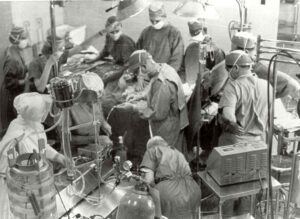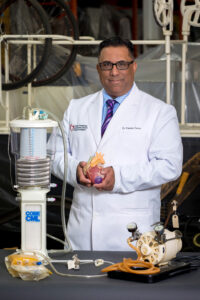The first patient to undergo open-heart surgery in Manitoba was a five-year-old boy from the community of Notre-Dame-de-Lourdes, on a chilly day in February 1959.

The operation, to repair a small hole in the boy’s heart, took seven hours and was performed at St. Boniface Hospital by Dr. Morley Cohen while his colleague, Dr. Richard Burrell, ran the heart-lung machine. Their team had trained for months to prepare for the procedure. Coen held the child’s heart in his hand while mending the hole; it stopped beating for eight minutes, and the organs remained exposed to the air for more than 20 minutes. Thankfully, the operation was a success.
Scope of cardiac procedures has changed
After the first operation, a dozen more open-heart surgeries were carried out at the Hospital in 1959. That number doubled the following year. Today, St. Boniface Hospital focuses on open-heart surgery cases in adults and completes more than 70 cases every month. Last year, 763 cases were completed despite the slowdown caused by the pandemic.
Dr. Rakesh Arora is the section head and medical director for the cardiac surgery and intensive-care cardiac surgery units at St. Boniface Hospital. If Cohen could see the open-heart surgery program as it stands today, Arora hopes he would be very proud of his legacy at the Hospital.
“We have a tradition of excellence at St. Boniface.”
“The types of procedures we’re doing, and the nature of the procedures, have changed,” said Arora. “We’re doing more complex valve procedures using the heart-lung machine; more cardiopulmonary bypass is the fancy term for it.”

In a nutshell, the program at St. Boniface has evolved to include four major pillars of cardiac surgery. The first has its roots in the boy’s operation and includes now-standard procedures like bypass grafting and valve surgery, which emerged in the last 40 to 50 years. The second pillar is more complex valve surgery, involving the section of the aorta that runs through the chest. The third pillar represents heart failure therapies for patients with poor-functioning heart muscles, as well as the use of durable implantable devices. The fourth pillar is improving the perioperative care of patients around the times of their surgeries, from admission to discharge.
“We have a tradition of excellence at St. Boniface,” said Arora. “Extending from the preoperative phase; to the team that works in the operating room, of perfusion (heart-lung bypass), nursing, anesthesia, and the surgeons; to the postoperative phase in the ICU and on the postoperative ward.”
“I think the things that have been key to that are a sense of teamwork, good communication tools, and a team that’s genuinely interested in the best results for our patients. I think that’s an important legacy that Dr. Cohen would be very proud of; that it was maintained after he departed from the program.”
Less invasive is the way of the future
In the future, the open-heart surgery program at the Hospital will move increasingly towards state-of-the-art and less-invasive procedures, said Arora. “We used the term open-heart at the outset. That is usually through a big cut through the breastbone, and that has been the traditional way of doing surgery from 1959 through to the current day,” he said.
“We are moving more into the area of what’s called minimally-invasive cardiac surgery. So, using imaging and other things, like little telescopes through the chest wall (laparoscopic surgery), to help improve surgery through smaller incisions. This is the new era of cardiac surgery.”
Arora also mentioned how such procedures will dovetail into the Hospital’s new, donor-supported endovascular hybrid operating room, slated to open next year.
Fight heart disease. Donate today.


